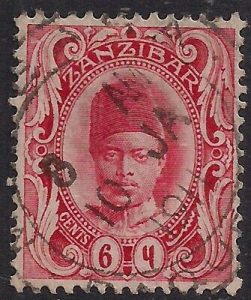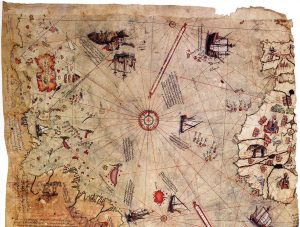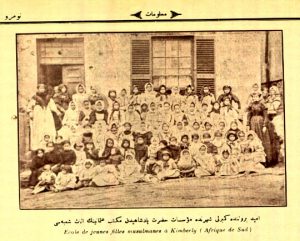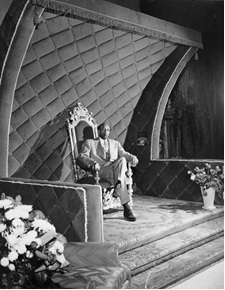Siyah: Zanzibar and Southern Africa: Imperial Visions and Ottoman Connections – Part II
This is the eighth instalment in ‘Siyah’, a series which explores African Diaspora and Turkish social and cultural narratives, with journalist Adama Juldeh Munu. Ahmet Kavas argues that there’s a multitude of information on the Ottoman’s influence in parts of North and East Africa, but not so much on southern Africa – particularly during the late 19th century. In the second part of his essay, Kavas focuses in greater detail on the Ottomans’ relationship with South African Muslims and other Southern African nations.
Today one of the historical events that is known both in Turkey and South Africa is the appointment of Ebubekir Efendi by the Sultan from Istanbul for the Muslims of South Africa on an exclusive mission.

The achievements of Ebubekir Efendi were not confined to South Africa. The Ottoman Empire even planned to find scholars like him and to send them to Europe. But it was really difficult to find scholars who had the same enthusiasm he had. Even while he was alive people knew his achievements but plans of finding another person like him were not realized. European colonialist states were afraid of the Ottoman Empire’s appointments of scholars like Ebubekir Efendi to various parts of Africa. Diplomatic missions of some special ambassadors such as Sadýk el-Müeyyed Pashaa who was sent to Ethiopia and Libya by Sultan Abdulhamid II, had been followed closely by the European embassies in those countries. Sadýk el-Müeyyed Pasha like Ebubekir Efendi was not satisfied with diplomatic missions but he also wrote what he observed and experienced and compiled these as a book. After sending Ebubekir Efendi to South Africa, the Ottoman Empire henceforth started to be interested in Muslims there more closely. A consul was appointed. They decided to open a school especially for educating Muslims there called Osmanlý Mektebi.
A newspaper called The Cape Argus provides comprehensive news about the school in South Africa opened by the Ottoman Empire:
“Hadje Emaum Magnoel Efendi, Professor of the Ottoman Arabic School in the Peninsula, has conveyed his loyal and dutiful sentiments to his Highness Muhmmed V., and a prayer for the new ruler has been given out for the Musselamn community in the Peninsula. Over 70 years ago, Hadje Effendi’s father was a member of the first Cape pilgrimage to Makkah, and it was in his return from the pilgrimage that for the first time a prayer for the Ottoman ruler was included in the service of the Peninsula Muslims. On receipt of a letter from Mecca officially announcing the elevation to the throne of his Highness Reshad Efendi as Sultan, the prayer for the new ruler was announced. It is the profound hope of the Muslims in the Cape that the new Sultan will not forget them, that he will continue the modest benefits from the Imperial Treasury for the widows and for the schooling of the orphan children of Muslem parents.”

The geographer Piri Reis provides a lot of valuable information about the Comoros Islands in his book called Kitâb-ý Bahriye (The Book of Navigation). But unfortunately, Ottoman intelligentsia didn’t follow the path he opened, as it deserved. There were times that even top-level state bureaucrats became ignorant of the information he provided. Comoros Islands wanted to inform Istanbul when the French started to colonize their land in the 1840s. The Sultan of Anjouan whose island was not colonized by the French caused the local people to suffer and tormented too much in cooperation with the British consul. Those local people who wanted to inform Istanbul of what was going on first sent two of their princes to London to complain to the consul. The Ottoman ambassador in London welcomed them, paid much attention, paid for all of their expenses in London and informed Istanbul of their visit. They were welcomed perfectly when they got to Istanbul and they were paid salaries as long as they stayed in the sultan’s palace. The thing that surprised the two princes was that many of the Ottoman authorities were not aware of their countries. In short this shows us that the information Piri Reis provided 300 years ago had just been left aside. In this era, the Suez Canal had not opened and Ottoman Empire kept contact with its fleets in Basra Gulf by going around Cape Town.
The Ottomans decided to transfer two princes with the first ship. It was the duty of the commander of the ship that, when they arrived in Comoros Islands, he was supposed to convey a letter containing some advice to be handed to the Sultan of Anjouan and he had to warn him orally not to torment his people. Dependence and devotion of Egypt, North Africa and East Africa is known. But the devotion of Muslims who lived in Southern Africa to the Ottoman Sultan is worth appreciation. They were so devoted and felt affiliated that even the workers in diamond mines sent greetings every year for the ceremonies on the anniversary of the start of Sultan Abdulhamid II’s ruling period:

“To his Imperial Majesty Sultan ul Ghazi Abdul hamid Khan II, Ruler of The Imperial Ottoman Empire, commander of the Faithful Ghadimoul harmain Sharifain. We the undersigned Aemma, Khotabah and Muezzins, representing the Colonial and Indian Mahomedans of the South African Diamond Fields, humbly desire with all reverence and affection to Express to Your Imperial Majesty on the occasion of your entry upon your fifteenth year our heartfelt wishes for your long life and happiness. It is with the deepest gratitude we remember that, although separated from Your Imperial Majesty by thousands of miles, we have yet been permitted to participate in the beneficence of your sway, and that Your Imperial Majesty has at all times evinced the kindliest interest in our social, moral and spiritual welfare. We on our part have watched with ever increasing pride the marked advancement which, under Divine Providence, the Ottoman nation has made during the fourteen years of your wise and just rule, and we pray that Your Imperial Majesty may long be spared to reign over loyal loving and prosperous people. To Your Imperial Majesty’s person the Mahomedans of the South African Diamond Fields are bound by all the ties of religion and affection. We are indebted to Your Imperial Majesty for the incalculable advantages of the Imperial Ottoman Free School, and are gratified to know that the spread of education among our. Musulman youth will in the coming years add to the undying glory of Your Imperial Majesty’s name. We humbly pray that all earthly blessings may be showered upon Your Imperial Majesty, that Your Imperial Majesty may enjoy all the happiness that attends a precious life devoted to the noblest aims, and that Your Imperial Majesty may long be shared to shed increased lustre upon a reign already made glorious in the annals of the far reaching Otoman Empire. We are Your Imperial Majesty’s most humble and loving servants.”
The Ottoman Empire constructed a railway between Istanbul and the sacred cities Makkaah and Medina. They expressed their support to all Muslims with this enterprise. Even Muslims of Mozambique’s capital city Loranso Marquiz sent donations among themselves to Istanbul, and in return they were gratified with a medal. Muslims living in the Island of Indian Oceans from Mauritius and Madagascar contacted the newly formed Turkish government in Ankara in the last days of Ottoman Empire. So aid between these countries was mutual not unilateral. Muslims from Mauritius helped the Ottomans after the war between Ottomans and Russians in 1877. Moreover, in the 1920s they collected some amount of money among themselves and sent it to the Ankara government after the national independence struggle was won.
During the first aid campaign, a person who was in the position of head of Muslims had written all the aid to the Ottoman consul. He also wanted to salute his people on national days in Ottoman clothes and demanded from Istanbul to send necessary things. All the things he asked were sent to him immediately. In the documents about the people of these islands we can see the pictures of the elite of the society wearing Ottoman clothes on important occasions.
Muslims of Mauritius and Madagascar exerted much effort to send the aid they collected to Ankara. They started campaigns for collecting aid for Turks waging war against Europeans and sent the collected aid to a magazine, Echos de l’Orient, published in Paris. The magazine announced to its readers the name of people who donated and what is donated:
“One of our friends in Tamatave, Mr. Ibrahim Mansour, was kind enough to send a cheque for 18,593 francs 55 cents to pass on to His E.E. Moustafa Kemal Pasha in Angora for the benefit of Turkish relief organizations. This sum is the proceeds of collections made in Madagascar and donations from our co-religionists in response or generous appeal from Mr. Ibrahim Mansour, to whom we are happy to address here our warm thanks as well as to all donors. We hope that our friends in Madagascar will be willing to continue their generous support because of the many difficulties we have to overcome in carrying out our task.”
Original essay published here: https://dergipark.org.tr/tr/download/article-file/582756


